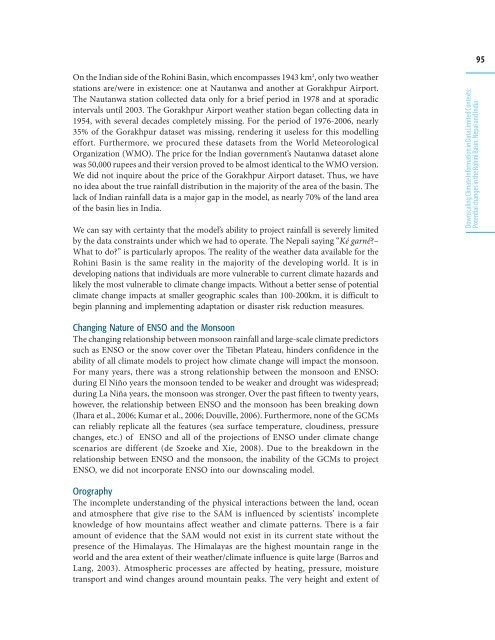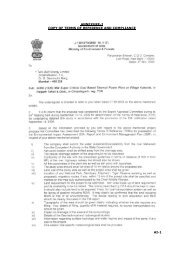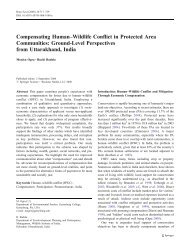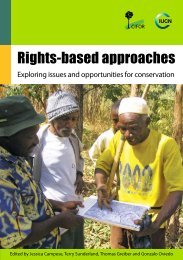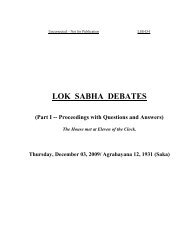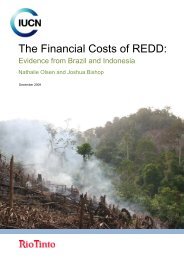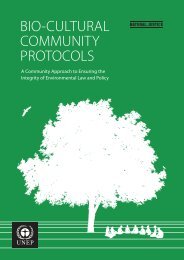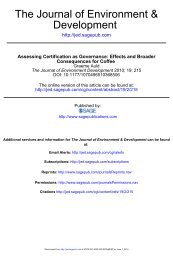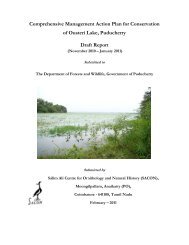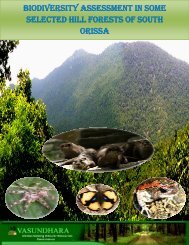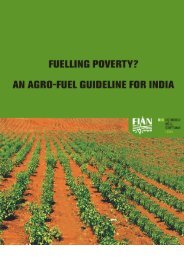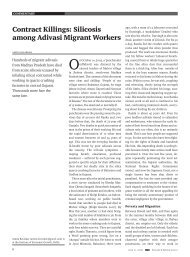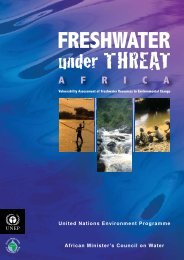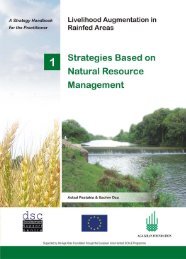Catalyzing Climate and Disaster Resilience: Processes for Identifying
Catalyzing Climate and Disaster Resilience: Processes for Identifying
Catalyzing Climate and Disaster Resilience: Processes for Identifying
You also want an ePaper? Increase the reach of your titles
YUMPU automatically turns print PDFs into web optimized ePapers that Google loves.
95<br />
On the Indian side of the Rohini Basin, which encompasses 1943 km 2 , only two weather<br />
stations are/were in existence: one at Nautanwa <strong>and</strong> another at Gorakhpur Airport.<br />
The Nautanwa station collected data only <strong>for</strong> a brief period in 1978 <strong>and</strong> at sporadic<br />
intervals until 2003. The Gorakhpur Airport weather station began collecting data in<br />
1954, with several decades completely missing. For the period of 1976-2006, nearly<br />
35% of the Gorakhpur dataset was missing, rendering it useless <strong>for</strong> this modelling<br />
ef<strong>for</strong>t. Furthermore, we procured these datasets from the World Meteorological<br />
Organization (WMO). The price <strong>for</strong> the Indian government’s Nautanwa dataset alone<br />
was 50,000 rupees <strong>and</strong> their version proved to be almost identical to the WMO version.<br />
We did not inquire about the price of the Gorakhpur Airport dataset. Thus, we have<br />
no idea about the true rainfall distribution in the majority of the area of the basin. The<br />
lack of Indian rainfall data is a major gap in the model, as nearly 70% of the l<strong>and</strong> area<br />
of the basin lies in India.<br />
We can say with certainty that the model’s ability to project rainfall is severely limited<br />
by the data constraints under which we had to operate. The Nepali saying “Ké garné?–<br />
What to do?” is particularly apropos. The reality of the weather data available <strong>for</strong> the<br />
Rohini Basin is the same reality in the majority of the developing world. It is in<br />
developing nations that individuals are more vulnerable to current climate hazards <strong>and</strong><br />
likely the most vulnerable to climate change impacts. Without a better sense of potential<br />
climate change impacts at smaller geographic scales than 100-200km, it is difficult to<br />
begin planning <strong>and</strong> implementing adaptation or disaster risk reduction measures.<br />
Downscaling <strong>Climate</strong> In<strong>for</strong>mation in Data Limited Contexts:<br />
Potential changes in the Rohini Basin, Nepal <strong>and</strong> India<br />
Changing Nature of ENSO <strong>and</strong> the Monsoon<br />
The changing relationship between monsoon rainfall <strong>and</strong> large-scale climate predictors<br />
such as ENSO or the snow cover over the Tibetan Plateau, hinders confidence in the<br />
ability of all climate models to project how climate change will impact the monsoon.<br />
For many years, there was a strong relationship between the monsoon <strong>and</strong> ENSO:<br />
during El Niño years the monsoon tended to be weaker <strong>and</strong> drought was widespread;<br />
during La Niña years, the monsoon was stronger. Over the past fifteen to twenty years,<br />
however, the relationship between ENSO <strong>and</strong> the monsoon has been breaking down<br />
(Ihara et al., 2006; Kumar et al., 2006; Douville, 2006). Furthermore, none of the GCMs<br />
can reliably replicate all the features (sea surface temperature, cloudiness, pressure<br />
changes, etc.) of ENSO <strong>and</strong> all of the projections of ENSO under climate change<br />
scenarios are different (de Szoeke <strong>and</strong> Xie, 2008). Due to the breakdown in the<br />
relationship between ENSO <strong>and</strong> the monsoon, the inability of the GCMs to project<br />
ENSO, we did not incorporate ENSO into our downscaling model.<br />
Orography<br />
The incomplete underst<strong>and</strong>ing of the physical interactions between the l<strong>and</strong>, ocean<br />
<strong>and</strong> atmosphere that give rise to the SAM is influenced by scientists’ incomplete<br />
knowledge of how mountains affect weather <strong>and</strong> climate patterns. There is a fair<br />
amount of evidence that the SAM would not exist in its current state without the<br />
presence of the Himalayas. The Himalayas are the highest mountain range in the<br />
world <strong>and</strong> the area extent of their weather/climate influence is quite large (Barros <strong>and</strong><br />
Lang, 2003). Atmospheric processes are affected by heating, pressure, moisture<br />
transport <strong>and</strong> wind changes around mountain peaks. The very height <strong>and</strong> extent of


